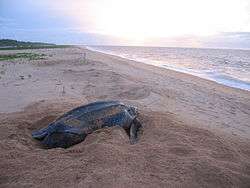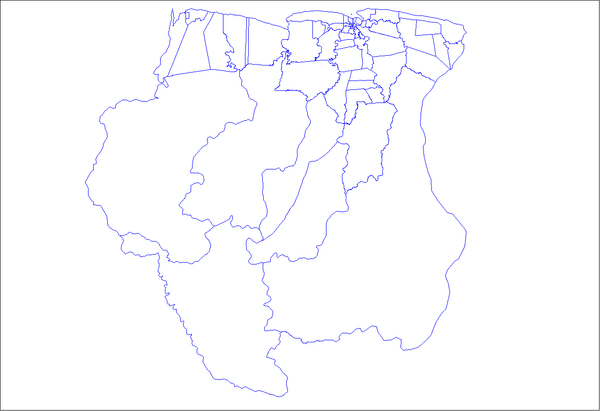Galibi, Suriname
Galibi is a resort in Suriname, located in the Marowijne District. Its population at the 2012 census was 741. Galibi is a tribal area inhabited by an indigenous population.[1]
Galibi | |
|---|---|
 Turtle on the beach of Galibi | |
 Map showing the resorts of Marowijne District.
Galibi | |
| Country | |
| District | Marowijne District |
| Area | |
| • Total | 1,014 km2 (392 sq mi) |
| Elevation | 0 m (0 ft) |
| Population (2012)[1] | |
| • Total | 741 |
| • Density | 0.73/km2 (1.9/sq mi) |
| Time zone | UTC-3 (AST) |
The town of Alusiaka used to be located near the banks of the Marowijne River. The Dutch West India Company was given 500 hectares to grow coconuts; but, because of their mistreatment of the workers, the town was abandoned.[2] In 1871 a 60-metre lighthouse was built near the entrance of the Marowijne; it was operated until 2012.[3]
Galibi Nature Reserve
The main attraction is the Galibi Nature Reserve. There is a beach at the mouth of the Marowijne River on the Atlantic Ocean. This section also has a small zoo and tourist shop. Tourists come to Galibi largely to see the Leatherback sea turtle. Its females migrate here from all over the world (including places as distant as Costa Rica, to lay their eggs in Suriname.[4] Almost half of the known population of leatherback turtles, lay their eggs in this area.[5]
Other turtles that frequent the beach are the Green sea turtle, the Olive ridley sea turtle, and the Hawksbill sea turtle [4] The area can only visited under strict supervision between February and June.[5]
Galibi has a small boat (korjaal) connection to Albina. The journey across the water takes about 1.5 hrs, and boats land near the villages of Christiaankondre and Langamankondre. There is a road connection to some parts of the resort Galibi, but not to the two main villages near the nature reserve. The residents believed that a road would have disturbed their peace and quiet.[6]
Wia Wia Nature Reserve
Founded in 1966, the Wia Wia Nature Reserve is located to the west of the Galibi Nature Reserve. It was also intended for the protection of the turtles; however, the focus has shifted to bird species.[7] The Wia Wia Nature Reserve has an area of 36,000 hectares.[8]
Further reading
- Protected Areas in Suriname: A Voice from Suriname’s Galibi Nature Reserve, Cultural Survival website
See also
References
- "Resorts in Suriname Census 2012" (PDF). Retrieved 21 May 2020.
- "Een geschiedenis van de Surinaamse literatuur. Deel 2". Digital Library for Dutch Literature (in Dutch). 2002. Retrieved 21 May 2020.
- "Lighthouses of Suriname". iBiblio.org. Retrieved 21 May 2020.
- "Galibi Tour naar Galibi Zeeschildpadden". Galibi Suriname (in Dutch and English). Retrieved 19 May 2020.
- "STRUCTUUR ANALYSE DISTRICTEN 2009-2013" (PDF). Planning Office Suriname (in Dutch). Retrieved 22 May 2020.
- "Galibi Suriname". Suriname Vakantiereis (in Dutch). Retrieved 21 May 2020.
- "Stichting Natuurbehoud Suriname". Stichting Natuurbehoud Suriname via Yellow.place (in Dutch). Retrieved 21 May 2020.
- "Natuur". Suriname Weetjes (in Dutch). Retrieved 25 May 2020.
External links
| Wikimedia Commons has media related to Galibi. |
